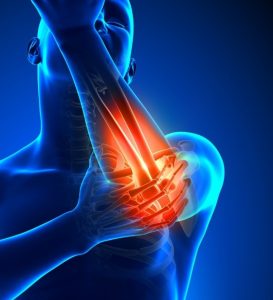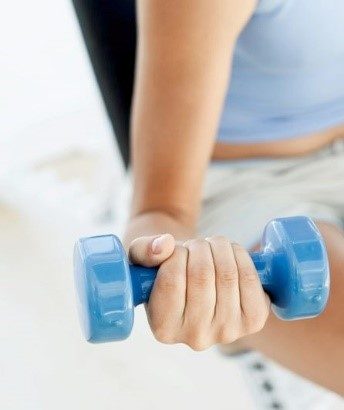tennis elbow
Tennis elbow is a chronic inflammation of the extensor tendon at the bony part of the outside of the elbow (the epicondyle) and is also known as ‘lateral epicondylitis’.
Tennis elbow can be the result of direct trauma but more often occurs over weeks or months of repetitive use of the extensor tendons at the elbow originating from the Extensor Carpi Radialis (ECRB) tendon. These tendons are active when twisting or gripping with the wrist. Affecting around 3 people in every 100, it's a common condition and certainly not restricted to tennis players.

Symptoms and presentation
Intial signs of tennis elbow are tenderness and pain when pressure is applied to the bony part of the outside of the elbow. This can develop into a dull constant pain or a sharp shooting pain that extends along the forearm or into the upper arm both at rest or when lifting an object or extending and twisting the wrist. The wrist and forearm may feel weak and there may be some stiffness in the elbow joint. Some swelling can occur.
It's important to note there are a number of other conditions which cause pain in the elbow including:
arthritis, shoulder impingement, pinched nerve in the neck and carpal tunnel syndrome
Treatment
Treatment for tennis elbow varies and is largely dependent on the severity and how long you've had symptoms. Rest is obviously a key part of recovery and avoiding the activities that aggravate the condition will allow the tendon tissue to heal.
For an acute injury that has occurred within a few weeks it's important to treat as early as possible or tennis elbow may become chronic and last for months.
If your symptoms are mild you can treat tennis elbow without medical intervention.
Rest your elbow and tendon wherever possible. If rest is not an option take regular breaks from activities which cause discomfort and pain.
Have your palm facing up rather than down when lifting objects. This puts less strain on the muscles of the forearm and therefore the tendon.
A clasp or strap can ease the pain by applying pressure on the relevant tendon or muscle and absorb and change the angle of force that can cause pain.
Pain medication in the form of paracetamol or ibuprofen will give relief and reduce inflammation. (Do not take for extended periods of time.)
Exercise
One of the most important ways to aid recovery and avoid re-injury is to incorporate progressive exercises to slowly increase your muscle’s strength without causing additional damage.
It may take seven to ten weeks to see a notable reduction in pain and an improved grip. It's important to stick with it for at least this long and to progress at the recommended rate. Treatment focused only on relieving pain rather than correcting the muscle weakness and bad habits that might have caused the condition will not help prevent it making an unwelcome return sometime in the future.
In cases that don't respond to rest, medication or strengthening exercises, it may be necessary to be referred for a steroid injection. These can provide immediate relief but do wear off over time. They may be a quick fix solution but do not provide the long term relief and reduced risk of re-injury that a strengthing programme will. If a steroid injection is necessary it is still vital to strengthen to avoid recurrence. Those who don't respond to an injection may ultimately be referred for surgery.

Prevention
The 3 most effective ways to prevent lateral epicondylitis are:
* A thorough warm up
* A structured stretching routine including both the flexors and extensors of the elbow and wrist
* A strength and conditioning programme for the forearm and wrists including for example, squeezing a tennis or stress ball and wrist curls using a small weight with the forearm pronated and supinated.
stretches
wrist flexion
wrist extension
supination
fist clench
towel twist

Modifying any activities that have led to the development of tennis elbow is an obvious way to prevent it happening again. This will include taking rest periods or retraining any muscle imbalances to take the strain off the wrist or elbow.
Muscular imbalances may occur further along the kinetic chain which need addressing, possibly in the shoulder or core muscle strength. Take a look at our online shoulder and core programmes.
If tennis elbow has been caused by playing tennis then it may be helpful to change your grip technique, grip size or string tension.
If you think you have tennis elbow we advise visiting a Doctor or physiotherapist for a diagnosis to rule out any tears to the tissue. If your elbow is inflammed wait until it has reduced before beginning any activities which can aggravate the condition. If you feel an increase in pain following activity cease the exercises and consult your Doctor or physiotherapist.
